
An image from Mars Pathfinder adjusted to give an accurate color portrayal of Mars surface and sky. Click to enlarge.
Mars Pathfinder. image NASA/NSSDC
Red ground, salmon sky and cyan sunsets.
by Paul Doherty
The View from Mars
If you were able to stand on Mars, suitably protected by a Mars suit, what would you see?
Here are some of my ideas of what you might see
illustrated by images from mars landers.
I've included my own images taken on earth for comparison.
The Color of Mars

An image from Mars Pathfinder adjusted to give an accurate
color portrayal of Mars surface and sky. Click to enlarge.
Mars Pathfinder. image NASA/NSSDC
The dust of mars is red, well actually it is butterscotch tan, because the dust of Mars is made from weathered "limonite" a brown iron oxide, (limonite is not actually a mineral but a mixture of hydrated iron oxide minerals such as goethite FeO(OH). Mars surface dust may also include red hematite, Fe2O3, one of the main ingredients of rust on Earth. The dust also contains 1% magnetite, Fe3O4, a magnetic mineral.
On earth iron containing minerals weather to a reddish color as well.

An earth image from Antarctica blue sky, red weathered
volcanic rock near Mt. Morning. Image by Paul Doherty
Activity: Drag a magnet through dirt or sand, it will collect iron particles and iron oxide particles and some yellowish/brown limonite.
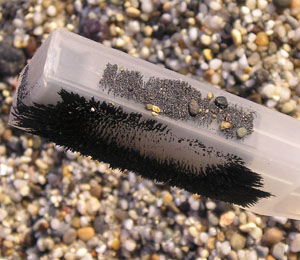
A magnet drawn through California beach sand collects black
magnetite and tan limonite.
Half the light at the surface of Mars comes from direct sunlight, half is scattered by the dust-filled sky, thus objects on Mars appear reddish in color.
Activity, find a pair of "Blue Blocker" sunglasses, these sunglasses look yellow-brown. Look at the world through these sunglasses to get an idea of what things would look like on Mars.


Left, Alissa shows off Blue Blocker Sunglasses. Right a view
of the whiteboard in our webcast theater through these
sunglasses.
Activity: eat butterscotch notice the color and think of Mars.
Without the dust the sky of Mars would be black as is the sky on earth at 115,000 feet the elevation at which the earth's atmosphere has the same density as the atmosphere at the surface of Mars.
Activity: The next time you are making a long distance flight in a 747 and the captain announces a cruising altitude near 50,000 feet look out the window to get an idea of what the sky would look like on Mars at the surface.
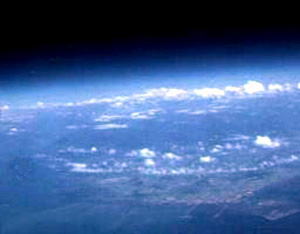
The sky of earth viewed from 50,000 feet elevation. The sky is
mostly black.
The red dust is blown into the sky on mars by winds, it settles out slowly and the finest dust remains suspended for very long times since it is never washed out of the air by rain.
The finest particles of dust on Mars are smaller than a wavelength of light, smaller than 0.5 micrometers. Some larger particles are tens of micrometers, much larger than a wavelength of red light.
The particles absorb blue light. They scatter all wavelengths of light. Thus the sky is colored reddish (all colors scattered minus blue light which is absorbed.)
The sky of Mars looks like the sky of Los Angeles when it is colored reddish by photochemical smog, which also absorbs blue light. Exhaust gasses from automobiles include nitrogen compounds which are converted into smog by the ultraviolet light in sunlight. After a rainstorm in Los Angeles the sky is cleared of smog and the blue sky of earth returns again, briefly.

Smog over Los Angeles. The brownish color is due to
photochemical smog, mostly nitrogen oxides. The color here is due to
molecular absorption of blue light, unlike Mars where particles
absorb and scatter light. Image EPA.
Sunrise Sunset
Sunrises and sunsets seen through the atmosphere of Mars appear greenish-blue or cyan.

Mars sunset panorama with accurate colors. Note bluish region
around the sun. Image NASA/NSSDC.
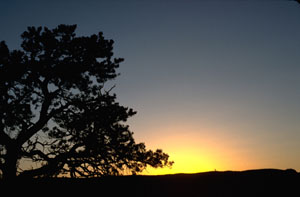
Earth Sunset, note yellowish sky near the sunset amid blue sky. Image
Paul Doherty
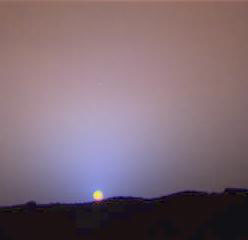
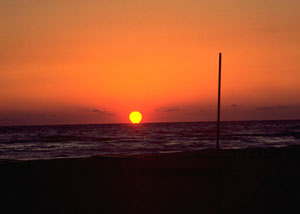
Mars sunset left from Pathfinder bluish sky around the sun against a
salmon colored sky, Earth sunset on right reddish sky around the sun
in a blue sky.Image left NASA/NSSDC, Image right Paul Doherty.
The sizes of the dust particles on Mars produce Mie scattering. This scatters blue light more strongly along the line from the sun to the dust particle. Thus at sunset when the sunlight passes through the largest amount of dust, the sky near the sun becomes bluish with the "forward" scattered blue light.
Clouds on Mars
The clouds of Mars contain water ice and maybe carbon dioxide ice. High thin ice clouds often form above the polar caps and over the high mountains of Mars, the white clouds of Olympus Mons are visible through Earth based telescopes. The pathfinder spacecraft viewed clouds made of water ice crystals covering the Martian sky.
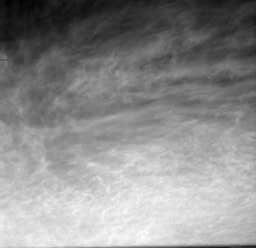
Cloudy sky on Mars from Pathfinder. Image NASA/NSSDC
Seeing Earth from the surface of Mars
You would be able to see the earth from the surface of Mars on a clear night, the moon too. When Pathfinder attempted to make an image of the earth from the surface of Mars, clouds got in the way. However, orbiting spacecraft have been able to image the earth and the moon from Mars.

The Earth and Moon photographed from Mars orbit. Image NASA/JPL/Malin
Space Science Systems
Rocky Surface of Mars
Rocks are scattered about the surface of mars, excavated by meteor impacts and shaped by windblown sand these rocks look similar to those in the dry valleys of Antarctica where it hasn't rained for millennia.

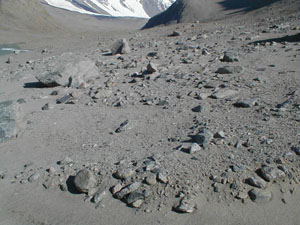
Left. Pathfinder view of the rocky surface of Mars. Right,
Rocky surface in the Dry Valley's of Antarctica. Left image
NASA/NSSDC, right image Paul Doherty.
Dust storms
The winds of Mars create huge dust storms. These sometimes grow to cover the entire planet. During the dust bowl era of the 1930's on earth huge dust storms blew across the United States. Historical photographs give us an idea of what an approaching dust storm on Mars might look like.
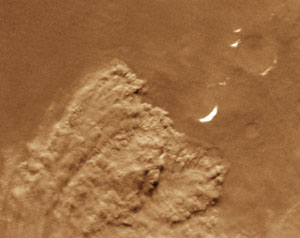
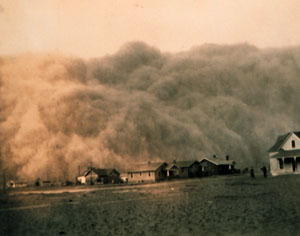
Left, Mars dust storm viewed from orbit, note craters with
snowy rims. Right, Earth dust storm during the "dust bowl" era. Mars
image Viking NASA/JPL, earth image NOAA
Dust Devils
We have photographed dust devils on Mars, they cast shadows and also leave tracks across the surface of Mars.
The dust devils on Mars can grow to heights much greater than those on earth, a large dust devil on earth might be a few hundred feet high, on Mars the dust devils can be 24,000 feet high, as high as some of the highest mountains on Earth.
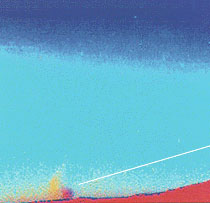
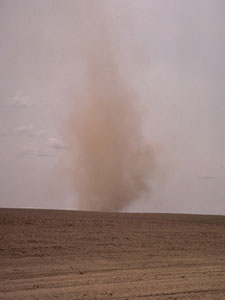
Left, Dust devil on Mars, false color image, it was
photographed in the distance from the pathfinder lander. Right, dust
devil on earth. Left image Pathfinder/Nasa/NSSDC, right image Paul
Doherty.
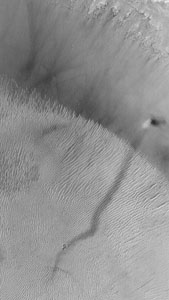
On Mars a dust devil moves across the floor of a crater and up the
crater wall.
It leaves behind a dark path where light dust is scoured from the
surface. The dust devil casts a shadow to the right.
Image NASA/JPL/Malin Space Science Systems
You can observe dust devils on earth in dusty deserts on hot sunny afternoons. I've seen many large dust devils on my visits to the Atacama desert of Chile. On a calm day, when a dust devil hits you it first blows you to one side and then the wind direction quickly reverses and blows you the other way, then the wind stops again.
We have a small sample of the Zagami meteorite which came from Mars. It fell near Zagami Rock in Nigeria in 1962, a farmer chasing cows from his corn field saw it fall. It is a member of the Shergotite group of Martian meteorites and contains trapped martian atmospheric gasses in its glasses. It is an igneous rock containing pyroxene whose plagioclase was converted to glass (maskelynite). The rock formed 160 million years ago, and it was blasted off the Martian surface 2.6 million years ago.
I started the program with these images which had just arrived from
Mars.
Here is the first panorama from the spirit lander in Gusev crater

The first view of Gusev Crater from the Spirit Lander. It's
near susnet. Click to enlarge.
Notice the flat terrain on theGusev crater floor with a few rocks, the larger rocks at the left of the image look like ventifacts with flat faces shaped by the wind. There are also lighter sand dune like deposits inside of a depression..
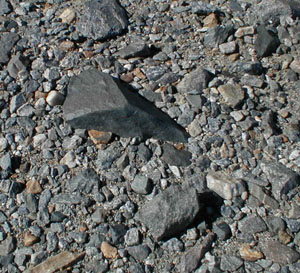
Ventifact in the Antarctic Dry Valleys.Flat faces with sharp
edges carved by the wind.Click to enlarge.
It looks like safe terrain to drive across with a few rocks and sand deposits to visit.
Here is the complete view around the lander presented in a circular format.
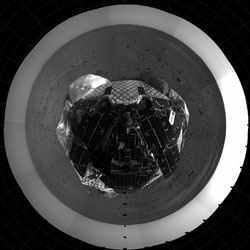
The complete landscape view. Click to enlarge.
Looking around the landscape notice the distant hills on the horizon.
|
Scientific Explorations with Paul Doherty |
|
25 Dec 2003 |